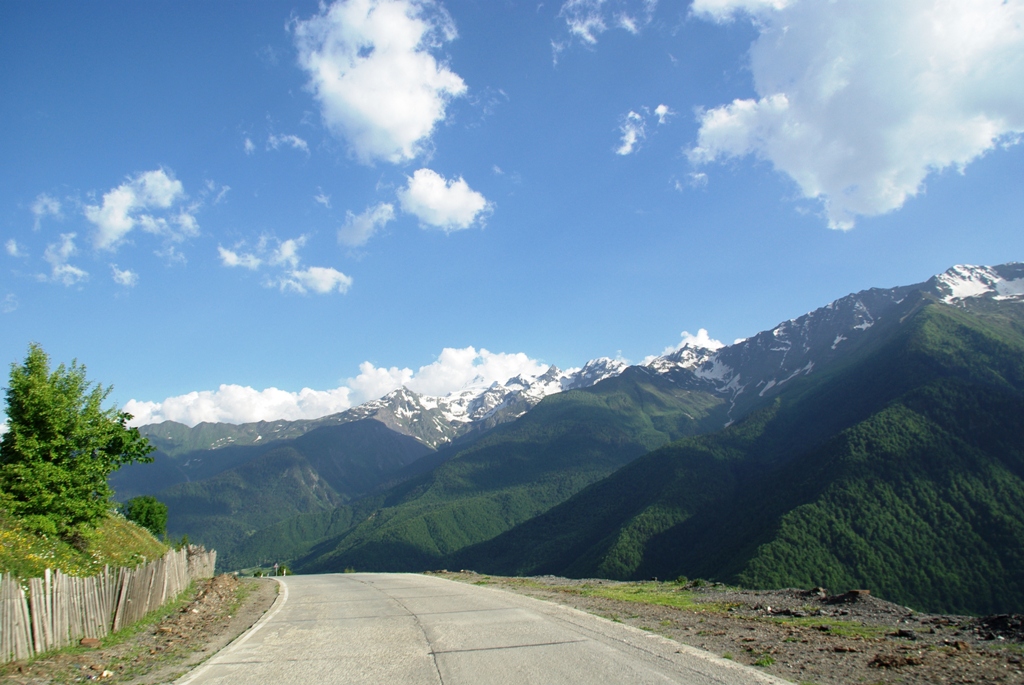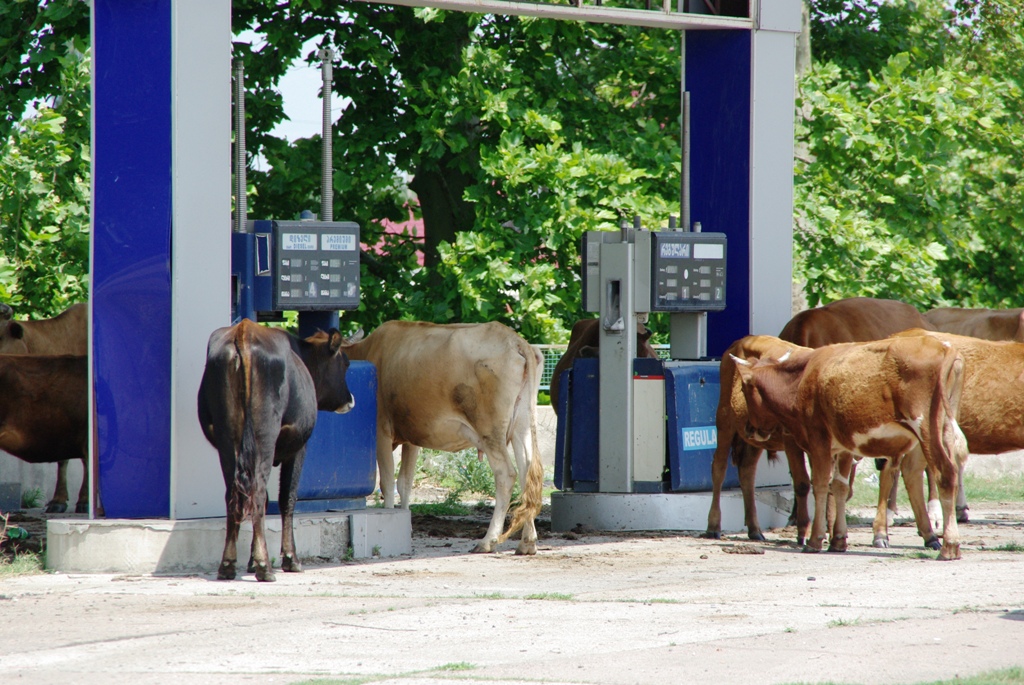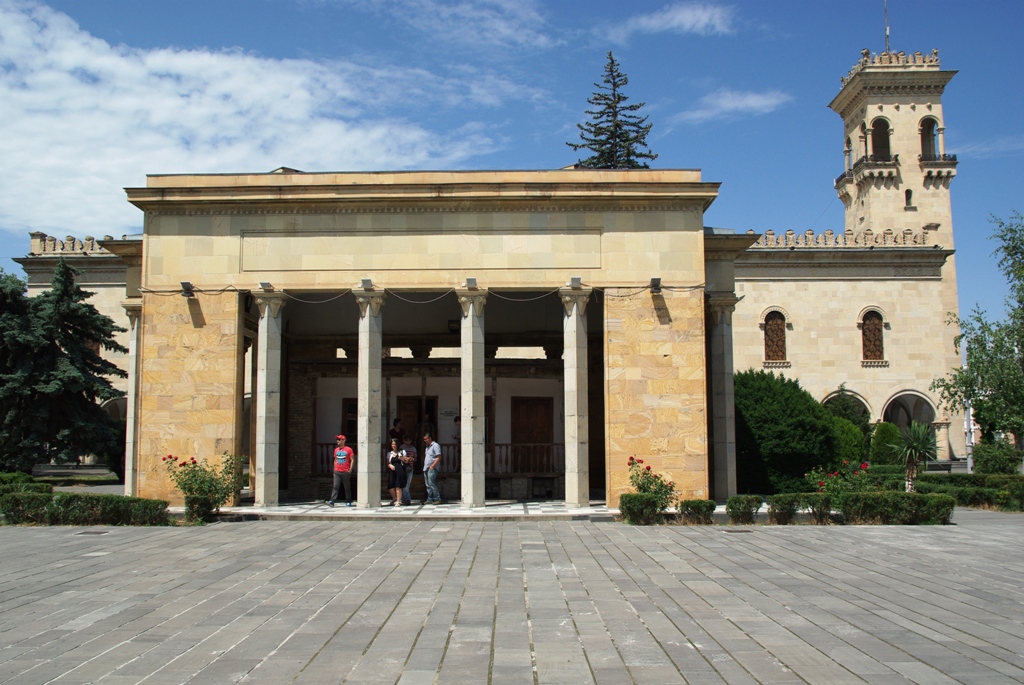There is no problem entering Ajara, and it has its own status in the Georgian law. But entering Abkhazia is a whole different story, for official Georgia has no contact with them. Furthermore, you need a visa to visit Abkhazia and you can only get it in Abkhazia itself. First you have to ask for the entrance pass (http://mfaapsny.org/en/council/visa.php) which allows you to enter the territory and then you get three days to get a visa. It is very similar if you want to enter South Ossetia, which also has a closed border to Georgia. There are some indications that you can cross the border near the town of Gori. At the time that Georgia proclaimed independency from the Soviet Union Abkhazia and South Ossetia proclaimed independency from Georgia. It is, however, possible to reach both territories from the Russian Federation, after all the paperwork has been cleared.
Despite its complicated situation, Georgia is a very safe country, with 4.5 million people, with about a third living in the nation’s capital Tbilisi. Georgia is proud of its Caucasus Mountains, with quite a few peaks higher than Mont Blanc, which falsely holds the title of the tallest mountain on the European continent. The tallest peak in Georgia is Shkhara, with 5.201 meters, but is not the tallest mountain in the Caucasus. That would be the Elbrus in neighbouring Russia, with 5.642 meters, being 850m taller than Mont Blanc.

So let us travel Georgia in the tall mountains from which we descend to the capital – Tbilisi, at the elevation between 380 and 770 meters.
Mestia is the capital of the Svaneti territory and has rich history. It is known for traditional defence towers, which are part of the UNESCO world heritage sights. Mestia is also the last town connected with an asphalt road, which is – regarding the elevation of the town – in a very good shape. Mestia stands at 1.5000 meters above sea level and is a great starting point for mountaineering, climbing and skiing. Georgia is known for tour skiing, where a helicopter takes the skier to the mountains. Mestia has everything a city needs, even though it only has 2.600 people. The entire region with over 300 km2 has 14.200 people (both data according to the 2002 census) and 132 villages. There is an international airport in Mestia, a county court, many opportunities to spend a night (from hotels to boarding houses which have a special home atmosphere to it). Considering the exclusive location, the price is more than acceptable. You can get a private board with a traditional Georgian breakfast for around 20€.
Mestia is also one of the two places from which you can reach the village Ushguli, which is the highest permanent settlement on the European continent with elevation from 2.100 to 2.410 meters. Unlike Mestia, you can reach Ushguli only by an off road vehicle and for most part of the year only from Mestia. The road connecting Ushguli with Lentekhij is ofet closed due to landslides or water. I was in luck that during my stay the road was open, so I was able to continue to Tbilisi cross Lentekhi, which I reached after a 3 hour drive (for 70kilometers) over the high mountain pass of Zagar (elevation 2.620m).
Ushguli, even though it’s not easy to reach, is one of the things you should not miss if you’re in Georgia! It’s a part of the world that has survived centuries being clenched between 5.000m tall mountains and courageously pushed back every possible invader. Today you can meet people there, who withstand harsh winters and isolation from the rest of the world. You can also find a place to spend a night, for a reasonable price, but in only a humble facility.
Cows rule! Driving the sideways you get the feeling that cows started to run the country. There’s cows wherever you look, but most of all they like to stay in the shade. They’re in the shade under the roof of a bus stop or a gas station, or if there’s no such luxury around, they stand in the middle of a bridge to catch a bit of a breeze that accompanies a cool river. It is anything but unusual to find a bridge with dozen of cows lazing on it, with no basic understanding of the need to move before an on-going car. So you need to zig-zag between them hoping every now and then one might move a head, if not the whole body for a step or two.

Tbilisi is a capital city with a million and half inhabitants and a mixture of past and present. It was funded by the monarch of Georgia - Vakhtang Gorgasali – in the 5th century, but was not a capital for long. Already his successor moved the capital to a 20 kilometre distant Mtskheto, which was only the capital of eastern Georgia. After wars with Turks in the 12 century Tbilisi became the capital again – this time of a unified Georgia. The largest territory ever to be under the control of Tbilisi was that of the Trans Caucasus Soviet Socialist Republic (between 1921 and 1936) that included, apart from Georgia, Azerbaijan and Armenia. From then on and until its independence in 1991 Tbilisi was the capital of the Soviet Socialist Republic of Georgia.
The city is, not only through history, a mixture of various influences that have shaped it and thus we can find various interesting architectural combinations. The most pompous masterpiece of the modern Tbilisi is the Bridge of Peace. It’s a pedestrian bridge covered by glass roofing and lighted by LED lights, which gain a special charm at night. Because of the great difference in elevation between the river bank and the higher parts of the city Tbilisi features both clog railway and cable cart, which was just being finished at the time of my visit.
The lower part of the city has all the important museums and galleries, the old town, the oldest church, pedestrian streets full of shops for tourists, bars and restaurants. The upper part of the city has a different kind of fun! It has an amusement park for the young and for the adrenalin addicts. There is also a fortress above the old town, with a good view of the river Mt'k'vari. On the other bank of the river are the presidential palace and the cathedral, with a modern park with fountains dancing and changing colours in the rhythm of music.
You will have something to see and do if you stay in Tbilisi and you will not need your own set of wheels. It is very well covered by public transport – from the underground to the “Maršrutka” which cover every part of the city. The prices for taxi are also reasonable, so getting around town is not a problem.
But not to write too much about the history of Georgia, I suggest you visit the most importaint museums, maybe even the museum of the Soviet occupation, as they now call the period between 1921 and 1991.
Gori, a town 80km from Tbilisi, reachable by the only motorway in Georgia, is the opposite to the capita. If Tbilisi features the museum of Soviet occupation, the biggest attraction of Gori is the birth house of Stalin and a museum dedicated to the Soviet statesman who fought and won the 2nd World War along with Churchill and Roosevelt, but the memory of this statesman were diminished due to the post war deportations to gulags. Next to the birth house is the only preserved building in the once poor part of town – but is now the central part of the city, where we can see Stalin’s personal railroad coach and museum with photos and personal belongings. Among other sights I should mention the fortress, but it’s in a bad shape. Gori was strategically important city, which still has its strategic value. This was seen in 2008 when the forces of South Ossetia took control of the city, with the help of Russian military, but left it on August 22nd. Today there are important army barracks of the Georgian army in the city, because the city is very close to the dividing line with South Ossetia.

Georgia and wine are like peas in a pot. So we can find modern wine makers as well as traditiojnal wine makers, which use methods which are a few millennia old. Georgia has 525 types of wine grapes that all conquerors tried to destroy. Georgian soldiers always had seeds of grape wines in their pockets, so they could protect and preserve the biggest national treasure even if they’d die, for the grape would start to grow after they’d be buried. The thousands of years of winery tradition is best seen in the winery »Pheasant's tears« in the town of Sighnaghi, which is an hour and a half drive from Tbilisi by “Maršrutka”. They will be very proud to show you the organic wine which they produce with no chemicals and a small cellar, where they demonstrate how they produce wine and the wine brandy named »Čača«, from the grape remains after they have been pressed for wine.
And apart from wine, Sighnaghi is a town described as the most beautiful in Georgia. It features the old wall and a church or two, but most of the city was only recently renovated. They started renovating the outside, the facades, so it’s interesting to sneak a peek through a window or two and see some interesting rubble on the inside. But if you’re not too picky and just enjoy what you see, you’ll spend some nice hours in Sighnaghi.
But there are also some other towns you should visit to get a full picture of Georgian wine story, among other the capital of the wine region Kakheti – the town of Telavi.
Georgian military highway is the next sight to see in Georgia and connects the city of Mtskheto with Vladikavkaz in Russia and was built after Georgia was joined to the Russian Empire in the beginning of the 19th century. It’s over 200 kilometres long and rises over the 2.379m tall pass of Jvari (meaning cross). There are some nice view points along the road. The elevation also makes sure, you get to cool down in hot summer months, especially while looking at snow covered peaks of over 5.000 meters.
Black Sea coast with the largest city and capital of the autonomous region Ajare - Batumi is just perfect for summer months, that’s why they call Batumi the summer capital of Georgia. Unfortunately I haven’t reached it yet, so I can’t tell you more about it, but I can describe Poti, an important harbour town. It has some old buildings and a nice park, but we cannot say it’s among more beautiful cities. It’s a freight harbour. The beaches are abandoned and dirty, with only a few places where you can spend a night. So Poti is definitely not a place, where you should go on a hot summer day.
Where to stay in Georgia?
There are many small guest houses with a few rooms, with a real touch of home. The two biggest cities – Tbilisi and Batumi on the coast – also feature a
Youth Hostel. Tbilisi hostel is in the centre of the old town, right under the fortress and in Batumi both hostels are just a few blocks away from the beach. You can book a stay at any of the three hostels through
www.youth-hostel.si, where there are also some good tips to be found.